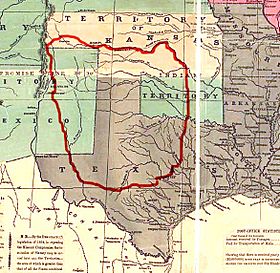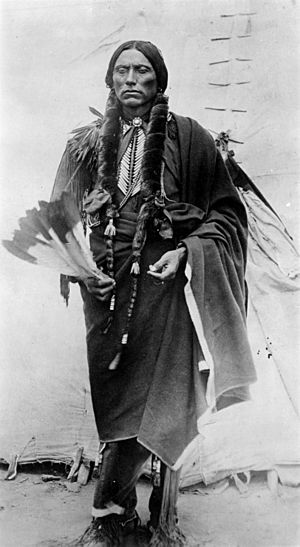Comanche Wars facts for kids
Quick facts for kids Comanche Wars |
|||||||
|---|---|---|---|---|---|---|---|
| Part of the Texas–Indian wars | |||||||
 A map showing the Comanche lands (Comancheria) during the 1800s |
|||||||
|
|||||||
| Belligerents | |||||||
Texas Comanche wars 1836 – 1875 |
|||||||
The Comanche Wars were a long series of fights between the Comanche people and the armies and settlers from Spain, Mexico, and the United States. These conflicts took place in what is now the United States and Mexico. They started around 1706 and lasted until the mid-1870s.
The Comanche were a powerful Native American tribe. They lived in a large area called Comancheria. This land stretched across the southern Great Plains. It included parts of Colorado, Kansas, Oklahoma, Texas, New Mexico, and even into Chihuahua, Mexico. For over 150 years, the Comanche were known as "the Lords of the Southern Plains" because they were so strong in the region. They also shared parts of their land with other tribes like the Wichita, Kiowa, Kiowa Apache, Cheyenne, and Arapaho.
European-American settlers wanted to move into the American frontier. This desire for land quickly led to clashes with the Comanche. The Comanche Wars began when Comanche warriors raided Spanish colonies in 1706. The fighting continued until most Comanche groups surrendered to the United States Army in 1875. Some Comanche still fought in later battles, like the Buffalo Hunters' War in 1876 and 1877. The Comanche were known for being fierce fighters. They strongly resisted outsiders trying to take their lands.
Comanche power was at its strongest in the 1840s. During this time, they led huge raids deep into Mexico. They also fought against Anglo-Americans and Tejanos who had settled in independent Texas. However, their power began to fade. Diseases like cholera and smallpox caused many deaths among their people. Also, the growing population of the United States pushed them to give up most of their tribal lands.
Contents
- Key People in the Comanche Wars
- Major Battles and Campaigns
- Fort Parker Massacre: A Surprise Attack (May 1836)
- Council House Fight: Peace Talks Turn Violent (March 1840)
- Battle of Plum Creek: A Fierce Response (August 1840)
- Antelope Hills Expedition: Into Comanche Territory (January–May 1858)
- Battle of Pease River: The Recapture of Cynthia Ann Parker (December 1860)
- First Battle of Adobe Walls: A Stand Against the Army (November 1864)
Key People in the Comanche Wars
Iron Jacket: A Brave Comanche Chief
Iron Jacket was a respected Comanche chief and medicine man. He got his name because he wore a special coat of mail into battle. This coat was like armor. Iron Jacket fought in the Antelope Hills Expedition in 1858. He was killed during the Battle of Little Robe Creek. He was also the father of Peta Nocona, who later became a chief too.
Cynthia Ann Parker: A Story of Two Worlds
Comanche warriors attacked Fort Parker in Texas. They kidnapped nine-year-old Cynthia Ann Parker and other children. Cynthia Ann quickly became part of the Comanche tribe. She later married the Comanche chief Peta Nocona. Cynthia Ann Parker had a son named Quanah Parker. He grew up to become a famous chief and led a war party in 1874.
Peta Nocona: A Powerful Comanche Leader
Peta Nocona was a Comanche Chief. He played a very important role in the Indian Wars. He was also the father of Quanah Parker, the last Comanche Chief. Peta Nocona led the attack on Fort Parker where Cynthia Ann Parker was captured. She later became his wife. The exact place and date of Peta Nocona's death are still debated by historians.
Quanah Parker: The Last Comanche Chief

Quanah Parker was the last Comanche Chief. He belonged to the Quahadi group of the Comanche, who were highly respected. Quanah was never officially chosen by his people as chief. Instead, the United States government appointed him to the position. Before he became a chief, Quanah Parker saw the peace talks of 1867. However, he refused to sign the agreements at that time.
Buffalo Hump: A War Chief's Revenge
Buffalo Hump was a Comanche War Chief. He led the famous Great Raid of 1840. This raid happened after Texas officials killed Comanche leaders during the Council House Fight. Buffalo Hump wanted revenge for his people.
Mirabeau B. Lamar: A President's Tough Stance
Mirabeau B. Lamar was the second President of the Republic of Texas. He served from 1838 to 1841. He had a much stricter policy towards Native Americans in Texas than the previous president. Lamar signed two laws that made tensions worse in the region. One law created an 840-man army to protect Texas's northern and western borders. Another law added 8 more groups of mounted volunteers to serve for six months.
Santa Anna: A Chief for Resistance and Peace
Santa Anna was a Comanche war chief. He believed in fighting back against the Texas settlers. He became very important after the Council House Fight in San Antonio in 1840. Santa Anna joined forces with Buffalo Hump. He likely took part in the Battle of Plum Creek and the Great Raid of 1840. Santa Anna was the first of his tribe to travel to Washington D.C. He agreed to sign a treaty in May 1846, even though fighting continued. Santa Anna died from a cholera outbreak in 1849.
Major Battles and Campaigns
Fort Parker Massacre: A Surprise Attack (May 1836)
The Fort Parker Massacre was a raid by several tribes, including the Comanches, Kiowas, Caddos, and Wichitas. They attacked the fort, killing five people. They also captured several others. Among those captured was nine-year-old Cynthia Ann Parker. She later married the Comanche chief Peta Nocona. Other captives included John Richard Parker, Rachel Plummer and her son James Pratt Plummer, and Elizabeth Duty Kellog.
Council House Fight: Peace Talks Turn Violent (March 1840)
The Council House Fight happened on March 19, 1840. It was supposed to be a peace meeting between Comanche leaders and Texas officials. The talks were about getting back Texans and Mexicans held captive by the Comanches. The Comanches wanted to trade these captives for parts of Comancheria that Texas had claimed. The meeting ended in violence. Twelve Comanche leaders were killed inside the Council House. Another 23 were shot in San Antonio.
Battle of Plum Creek: A Fierce Response (August 1840)
The Battle of Plum Creek took place near Lockhart, Texas on August 12, 1840. Chief Buffalo Hump led about 1,000 Comanche warriors. They attacked 200 Texas Rangers. This was a direct response to the Council House Fight. The battle started as a raid where the Comanches stole animals and weapons. It then turned into a gunfight. The exact results of the battle are still debated. Rangers reported 80 Comanches killed, but only 12 bodies were found. The Comanches claimed they killed 11 Texas Rangers.
Antelope Hills Expedition: Into Comanche Territory (January–May 1858)
The Antelope Hills Expedition was a military campaign. The federal 2nd Cavalry led it against the Comanche and Kiowa tribes in Comancheria. It lasted from January to May 1858. The expedition happened because of Comanche raids into Texas. Peta Nocona and Iron Jacket led Comanche forces against the 2nd Cavalry. The U.S. forces also had help from the Tonkawa, Nadaco, and Shawnee tribes, who were enemies of the Comanche. The expedition aimed to move the 2nd Cavalry from Oklahoma to Texas to better handle the raids. In the end, 50 U.S. soldiers and allies were killed. On the Comanche side, 76 were killed and 16 were captured. The Antelope Hills Expedition also led to the Battle of Little Robe Creek.
Battle of Little Robe Creek: A Costly Fight
The Battle of Little Robe Creek (also called the Battle of Antelope Hills) was a major fight. It involved the Comanches, Kiowas, and Apaches against the Texas Rangers and their allies. The Rangers' allies included the Tonkawa, Caddo, Anadarko, Waco, Shawnee, Delaware, and Tahaucano. This battle was the first time the Texas Rangers entered the Comanche land of Comancheria.
The United States had about 100 Texas Rangers and 113 allies. The Comanches had between 200 and 600 warriors. There were three main parts to the battle. The first part began on the morning of May 12. General Ford led the Texas Rangers in a surprise attack on a Comanche camp. The Comanches were not ready, and many were killed. The second part happened when the Rangers tried to attack another camp. This time, the Comanches were ready and fought back. They still lost many lives. In the third and final part, Comanche warriors were able to go on the offensive against the Texas Rangers. However, the overall result was very costly for the Comanche. 76 Comanche warriors were killed, and over 60 were captured. The Texas Rangers, in comparison, lost only two killed and five wounded.
Battle of Pease River: The Recapture of Cynthia Ann Parker (December 1860)
The Battle of Pease River took place on December 18, 1860, in Foard County, Texas. This event has been debated due to different stories and exaggerated facts. It likely started in November 1860. A group of Comanche warriors raided farms and settlements in nearby counties. They stole property and killed at least six people. Citizens chased the Comanches to a village on the Pease River. They waited for more soldiers to arrive.
Three units arrived, led by Lawrence Sullivan "Sul" Ross, Captain J.J. Cureton, and First Sergeant John W. Spangler. On December 19, 1860, Sul Ross led the attack on the Comanche village. According to Ross's report, they "killed twelve of the Comanches and captured three." The captives were a woman who turned out to be Cynthia Ann Parker, her daughter Topsannah (Prairie Flower), and a young boy. Ross brought the boy to Waco and named him Pease Ross. The whole event lasted only about twenty to thirty minutes.
First Battle of Adobe Walls: A Stand Against the Army (November 1864)
The First Battle of Adobe Walls was a fight between the United States Army and their Comanche allies, the Kiowa, and the Plains Apache. The battle began when Kit Carson attacked a Kiowa town. In response, the Kiowa and Comanches launched a counterattack with over 1,000 warriors. The battle was long and intense. The United States army almost ran out of ammunition.

